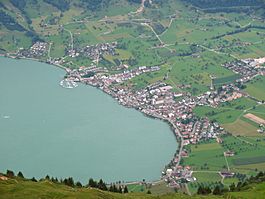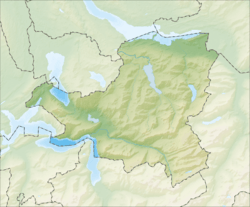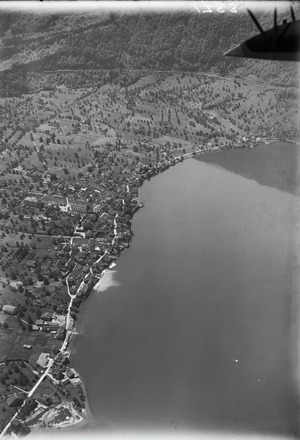Arth facts for kids
Quick facts for kids
Arth
|
||
|---|---|---|

The village Arth
|
||
|
||
| Country | Switzerland | |
| Canton | Schwyz | |
| District | Schwyz | |
| Area | ||
| • Total | 42.02 km2 (16.22 sq mi) | |
| Elevation
(Kirche Arth)
|
417 m (1,368 ft) | |
| Highest elevation
(Rigi Kulm)
|
1,798 m (5,899 ft) | |
| Lowest elevation
(Lake Zug)
|
413 m (1,355 ft) | |
| Population
(Dec 2020 )
|
||
| • Total | 12,184 | |
| • Density | 289.96/km2 (750.99/sq mi) | |
| Postal code |
6415 Arth, 6414 Oberarth, 6410 Goldau, 6410 Rigi Kulm, 6410 Rigi Staffel, 6410 Rigi Klösterli, 6356 Rigi Kaltbad
|
|
| Localities | Arth, Oberarth, Goldau, Rigi Kulm, Rigi Staffel, Rigi First, Rigi Klösterli, | |
| Surrounded by | Gersau, Küssnacht, Lauerz, Steinerberg, Vitznau (LU), Walchwil (ZG), Weggis (LU), Zug (ZG) | |
Arth is a village and a municipality in the canton of Schwyz in Switzerland. It's a small town located in the Schwyz District.
The municipality of Arth includes the main villages of Arth, Oberarth, and Goldau. It also covers four smaller settlements on the Rigi mountain: Rigi Kulm, Rigi First, Rigi Klösterli, and Rigi Staffel.
Contents
History of Arth
Arth was first mentioned in old records in the year 1036. Back then, it was called Arta. Later, in 1353, it was known as ze Arth.
Geography of Arth
Arth covers an area of about 42.1 square kilometers (16.3 square miles). A large part of this land, about 40.8%, is used for farming. Forests cover an even bigger part, about 46.3% of the area. About 8.5% of the land has buildings or roads. The remaining 4.3% includes natural features like rivers or mountains.
The municipality is located on the southern shore of Lake Zug. It sits along the important Gotthard route, nestled between the Rigi and Rossberg mountains. Besides the main villages of Arth, Oberarth, and Goldau, it also includes small communities like Klösterli and Kulm an der Rigi.
People and Population
Arth has a population of about 10,227 people (as of 2007). Over the past ten years, the number of people living here has grown by about 6.3%.
Most people in Arth speak German, which is about 86.9% of the population. The next most common languages are Albanian (3.9%) and Serbo-Croatian (3.2%).
In 2000, there were 3,806 households in Arth. About 30.4% of these households had only one person living in them. Around 7.2% were large households with five or more members.
Many adults in Arth have completed higher education. About 63.6% of people aged 25 to 64 have finished either advanced high school or a university degree.
Arth has a low unemployment rate of 1.55%. This means most people who want to work can find jobs. In 2005, many people worked in different areas:
- About 329 people worked in farming.
- About 810 people worked in manufacturing or construction.
- About 1868 people worked in services, like shops, hotels, or offices.
Most people in Arth are Roman Catholic (72.2%). About 9.8% belong to the Swiss Reformed Church. There are also smaller groups of people who follow other Christian faiths or Islam. Some people do not belong to any church.
The population of Arth has grown a lot over the years:
| year | population |
|---|---|
| 1743 | 2,134 |
| 1850 | 2,196 |
| 1900 | 4,739 |
| 1950 | 5,816 |
| 2000 | 9,593 |
| 2005 | 9,918 |
| 2007 | 10,227 |
Transportation
The railway station in Goldau is called Arth-Goldau. It's a very important train hub for the Swiss Federal Railways. Many different train lines meet here:
- The Voralpen Express connects to Luzern and St. Gallen.
- Trains heading to Bellinzona, Lugano, and Italy pass through here.
- Trains going to Zug and Zürich also connect with trains heading towards Basel.
Notable People from Arth
- Karl Jakob Weber (1712–1764): He was a Swiss architect and engineer born in Arth. He was famous for leading the first organized digs at ancient Roman cities like Herculaneum, Pompeii, and Stabiae.
- Robbie Hunter (born 1977): He is a retired professional road racing cyclist from South Africa. He competed from 1999 to 2013 and now lives in Arth.
Gallery
See also
 In Spanish: Arth para niños
In Spanish: Arth para niños








